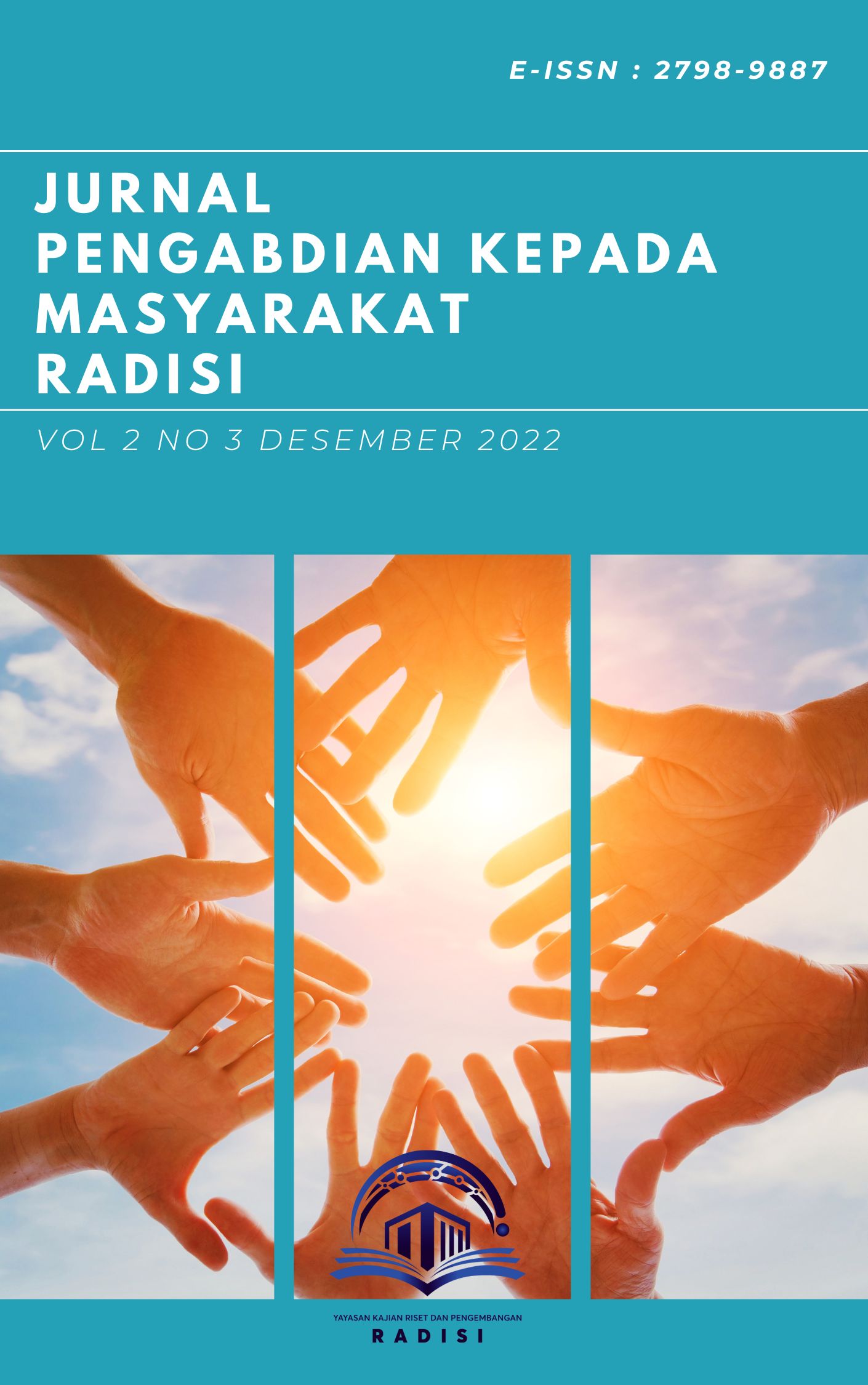Penerapan IPE dan IPC Pada Keluarga Dengan Rehabilitasi Stroke Di Kecamatan Percut Sei Tuan
DOI:
https://doi.org/10.55266/pkmradisi.v2i3.189Kata Kunci:
IPE dan IPC, Rehabilitasi stroke, Kec Percut Sei TuanAbstrak
Penerapan IPE dan IPC mengacu kepada kesempatan profesi Kesehatan dalam melakukan perawatan dan pelatihan dengan melibatkan profesi lain sebagai mitra. Metode dalam kegiatan ini menggunakan metode ceramah, pemeriksaan Kesehatan, dan pelatihan perawatan pasien stroke. Kegiatan ini melibatkan ahli gizi tenaga laboratorium, perawat, Kesehatan lingkungan dan farmasi yang akan membantu terlaksananya kegiatan pengabdian kepada masyarakat di Kecamatan Percut Sei Tuan. Peserta dalam kegiatan ini setelah melakukan survey lapangan dan mengunjungi langsung dan 8 rumah keluarga yang memiliki pasien dengan rehabilitasi stroke. Berdasarkan kegiatan yang dilakukan direkomendasikan agar pasien melakukan berbagai hal termasuk mengontrol gizi makanan, melaksanakan ROM (Range of Motion), meningkatkan gaya hidup sehat dengan perilaku “CERDIK”, yaitu, Cek Kesehatan secara berkala, Enyahkan asap rokok, Rajin aktivitas fisik, Diet sehat dan seimbang, Istirahat cukup dan Kelola stress, mengontrol pemakaian obat dan memelihara berat badan. Dengan kegiatan ini keluarga pasien dapat memahami cara perawatan pasien stroke secara mandiri dirumah serta tingkat kesadaran akan pentingnya melakukan konsultasi dengan tenaga kesehatan semakin meningkat.
Unduhan
Referensi
Bethea, D. P., Smith, N., Allison, L. K., Bell, C. S., Collins, M. E., Migliarese, S. J., & Darby, R. (2019). Live standardized patient scenario improves attitudes toward and readiness for interprofesisonal education in occupational therapy and physical therapy students. Journal of Allied Health, 48(2), 81–87
Bland, M., Stevens, A., Nellis, P., Mueggenburg, K., Yau, T., & Chen, J. C. (2020). Interprofessional education and transitions of care: a case-based educational pilot experience. Journal of Interprofessional Care, 1–5. https://doi.org/10.1080/13561820.2020.1769041.
C., P., C., S., B., S., M., P., P., L., & J., V. (2018). Development and preliminary assessment of interprofessional education focused on vulnerable populations. Journal of Allied Health, 47(3), e75–e81.
Gras, L. Z., Brown, S., Durnford, S., Fishel, S., Monroe, J. E., Plumeau, K., & Taves, J. V. (2019). Impact of a one-time interprofessional education event for rehabilitation after stroke for students in the health professions. Journal of Allied Health, 48(3), 167–171.
Homeyer, S., Hoffmann, W., Hingst, P., Oppermann, R. F., & Dreier-Wolfgramm, A. (2018). Effects of interprofessional education for medical and nursing students: Enablers, barriers and expectations for optimizing future interprofessional collaboration - a qualitative study. BMC Nursing, 17(1), 1–10. https://doi.org/10.1186/s12912-018-0279-x
Karpa, K., Pinto, C., Possanza, A., Dos Santos, J., Snyder, M., Salvadia, A., Panchik, D., Myers, R., Fink, M., & Dunlap, A. (2018). Stroke Simulation Activity: A Standardized Patient Case for Interprofessional Student Learning. MedEdPORTAL : The Journal of Teaching and Learning Resources, 14, 10698. https://doi.org/10.15766/mep_2374-8265.10698
Kusumaningrum, P. R., & Anggorowati, A. (2018). Interprofessional Education (IPE) Sebagai Upaya Membangun Kemampuan Perawat Dalam Berkolaborasi Dengan Tenaga Kesehatan Lain. Jurnal Kepemimpinan Dan Manajemen Keperawatan, 1(1), 14. https://doi.org/10.32584/jkmk.v1i1.72
McDonald, C. L., Fuhs, A. K., & Kartin, D. (2018). An examination of current stroke rehabilitation practice in Peru: Implications for interprofessional education. Journal of Interprofessional Care, 32(3), 329–338. https://doi.org/10.1080/13561820.2018.1425290
Olenick, M., Flowers, M., Muñecas, T., & Maltseva, T. (2019). Positive and negative factors that influence health care faculty intent to engage in interprofessional education (Ipe). Healthcare (Switzerland), 7(1), 29. https://doi.org/10.3390/healthcare7010029
Reeves, S., Pelone, F., Harrison, R., Goldman, J., & Zwarenstein, M. (2017). Interprofessional collaboration to improve professional practice and healthcare outcomes. In Cochrane Database of Systematic Reviews (Vol. 2017, Issue 6). John Wiley and Sons Ltd. https://doi.org/10.1002/14651858.CD000072.pub3
Schapmire, T. J., Head, B. A., Nash, W. A., Yankeelov, P. A., Furman, C. D., Brent Wright, R., Gopalraj, R., Gordon, B., Black, K. P., Jones, C., Hall-Faul, M., & Faul, A. C. (2018). Overcoming barriers to interprofessional education in gerontology: The interprofessional curriculum for the care of older adults. Advances in Medical Education and Practice, 9, 109–118. https://doi.org/10.2147/AMEP.S149863
Wong, P. S., Chen, Y. S., & Saw, P. S. (2021). Influencing factors and processes of interprofessional professional education (IPE). implementation. Medical Teacher, 43(S1), S39–S45. https://doi.org/10.1080/0142159X.2019.1672864
Unduhan
Diterbitkan
Cara Mengutip
Terbitan
Bagian
Lisensi
Hak Cipta (c) 2022 Indrawati Indrawati, Soep Soep, Eqlima Elfira, Diah Lestari Nasution

Artikel ini berlisensiCreative Commons Attribution-NonCommercial-ShareAlike 4.0 International License.






